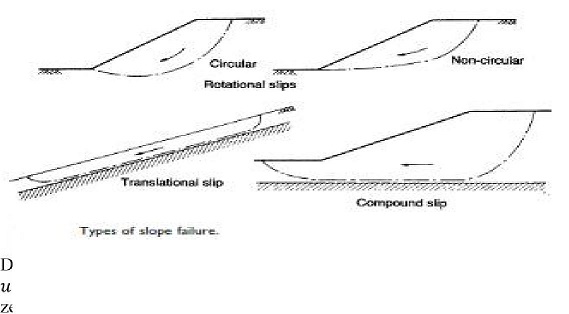Chapter: Civil : Soil Mechanics -Slope Stability
Slope Stability: Introduction

SLOPE STABILITY
INTRODUCTION
Gravitational
and seepage forces tend to cause instability in natural slopes, in slopes
formed by excavation and in the slopes of embankments. The most important types
of slope failure are illustrated in Figure. In rotational slips the shape of
the failure surface in section may be a circular arc or a non-circular curve.
In general, circular slips are associated with homogeneous, isotropic soil
conditions and non-circular slips with non-homogeneous conditions.
Translational and compound slips occur where the form of the failure surface is
influenced by the presence of an adjacent stratum of significantly different
strength, most of the failure surface being likely to pass through the stratum
of lower shear strength. The form of the surface would also be influenced by
the presence of discontinuities such as fissures and pre-existing slips.
Translational slips tend to occur where the adjacent stratum is at a relatively
shallow depth below the surface of the slope, the failure surface tending to be
plane and roughly parallel to the slope. Compound slips usually occur where the
adjacent stratum is at greater depth, the failure surface consisting of curved
and plane sections. In most cases, slope stability can be considered as a
two-dimensional problem, conditions of plane strain being assumed.
Design resisting moment. Characteristic values of
shear strength parameters c' and tan ?should be divided by factors 1.60
and 1.25, respectively. (However, the value of c' is zero if
the critical-state strength is used.) The characteristic value of parameter cu
should be divided by 1.40. A factor of unity is appropriate for the self-weight
of the soil and for pore water pressures. However, variable loads on the soil
surface adjacent to the slope should be multiplied by a factor of 1.30.
The following limit states should be considered as
appropriate:
1
Loss of overall stability due to slip failure.
2
Bearing resistance failure below embankments.
3
Internal erosion due to high hydraulic gradients
and/or poor compaction.
4
Failure as a result of surface erosion.
5
Failure due to hydraulic uplift.
Excessive
soil deformation resulting in structural damage to, or loss of service- ability
of, adjacent structures, highways or services.
Related Topics